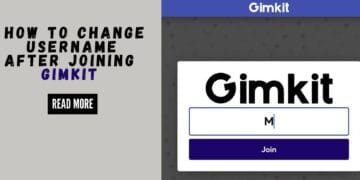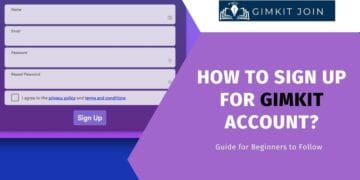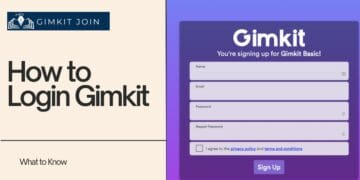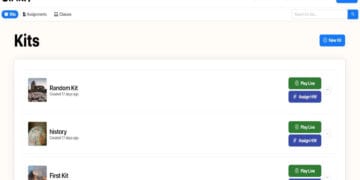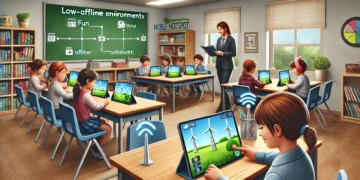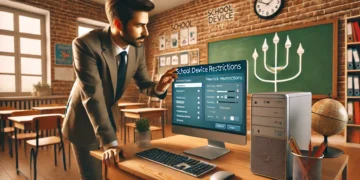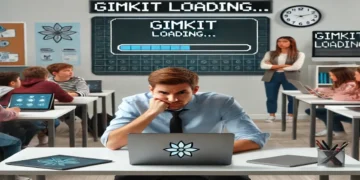Managing a classroom? It can feel like a circus sometimes. You want everyone to learn. You want them to be happy. But getting them focused is tough. What if your favorite game site could help with that? We can use Gimkit for good behavior! It’s a game changer.
You know the drill. Kids come in. They are buzzing. Some are loud. Others just sit there. Keeping everyone on track is hard. We often point out bad behavior. But let’s try something new. Let’s celebrate the good stuff. Let’s make class fun. Focusing on good behavior really works. It makes the class better. It helps kids learn more. Studies show this is true. Positive ways are best. They help kids for a long time. It makes them better learners. For deeper insights into these powerful strategies, Edutopia offers valuable guidance on positive behavior interventions.
This is where Gimkit shines. It’s not just for learning games. It helps with behavior too. Gimkit has game money. It gives out rewards. This makes it perfect. You can build a cool Gimkit reward system. You can even make a whole Gimkit classroom economy. This post will show you how. We’ll use Gimkit’s fun parts. We’ll boost student motivation. We’ll track good habits. We’ll set up a fun way to give rewards. Get ready for a classroom where kids love to learn.
Seeing How Gimkit’s Own Reward System Works: It’s More Than Just a Game
First, let’s look at Gimkit’s inside stuff. How do its rewards work? This helps us use it in our own class. It’s like peeking behind the curtain.
GimBucks & XP: The Start of Gimkit’s Money System
 Gimkit is not just about answering questions; it’s about feeling good. It’s about getting better. Gimkit uses two main kinds of virtual money. They are GimBucks and XP. These are like points. To learn more about how all of Gimkit’s features work, you can check out what are the main features of Gimkit.
Gimkit is not just about answering questions; it’s about feeling good. It’s about getting better. Gimkit uses two main kinds of virtual money. They are GimBucks and XP. These are like points. To learn more about how all of Gimkit’s features work, you can check out what are the main features of Gimkit.
Getting GimBucks: How Kids Earn Game Money
When kids play Gimkit games, they earn XP (Experience Points). XP comes from correct answers. It comes from leveling up. It also comes from doing things in the game. When they get enough XP, they level up. When they level up, they get GimBucks. This is a simple circle. Kids play. They get better. They earn rewards. Want to know which games give the most money? Check out which Gimkit game gives the most coins.
The Item Shop: What Kids Can “Buy”
So, what do kids do with their GimBucks? They go to the Item Shop. It’s like a tiny store. They can buy fun stuff for their “Gims.” Gims are their little game characters. They can buy new Gims. They can buy cool trails. These trails follow their Gim around. They can also buy stickers. These are fun pictures for the lobby.
The shop changes every week. This keeps it new. Kids always have something to save for. It’s a good goal. If your students are looking for ways to maximize their earnings, you might find advanced techniques for earning Gimkit coins helpful.
Knowing the Limits: Keeping Games Healthy
Gimkit even has limits. It has weekly XP caps. It suggests daily play times. This keeps kids from playing too much. It also teaches them a skill. They learn about saving. They learn about not overdoing things. That’s a good life lesson. For any issues with the game, you can check our guide on Gimkit not loading: common solutions.
Why Gimkit’s System Just Makes Kids Want to Play
 Think about why games are so fun. It’s because of these things. Gimkit puts them right into learning.
Think about why games are so fun. It’s because of these things. Gimkit puts them right into learning.
Instant Good Feelings: The “Yay!” Moment
Kids answer a question right. They see their GimBucks go up. They see their XP bar fill. This happens right away. This quick good feeling is powerful. It makes them want to keep trying. It keeps them playing. It keeps them learning. It’s a great example of using engagement strategies at school.
Setting Goals: Saving for a Cool Item
That special Gim costs money. That cool trail is not free. Kids learn to save their GimBucks. They have a goal. This makes them work harder. It makes them keep trying.
Seeing Progress: Watching Their “Money” Grow
They see their level go up. Their XP bar fills. Their GimBucks pile gets bigger. This shows them their hard work. It shows them how much they have achieved. This feeling of progress is a huge reason to keep going. You can also track student progress in Gimkit for even more insights.
Building Your Gimkit Classroom Economy: From Game Money to Real Rewards
This is the fun part! How do we use Gimkit’s game money? How do we use it for your real classroom? We will make GimBucks worth real things. This builds a great Gimkit classroom economy.
Naming Your “Gimkit Bucks” for Your Class
 First, connect the game money to your class. It needs a clear link.
First, connect the game money to your class. It needs a clear link.
Deciding How Much They Are Worth: Points for Money
How many GimBucks will equal a point? How many will be a “classroom dollar”? There’s no single right answer. Here are some ideas.
- Simple Swap: 100 GimBucks (from games) = 1 Classroom Point. Easy.
- More for Better Play: Top players get more points. Others get a point for playing.
- Bonus for Good Behavior: Extra points for being super focused.
It just needs to be clear. It needs to be the same for everyone.
Seeing Your Class Money: How to Keep Track
You need a way to track the “classroom GimBucks.” Both you and the kids need it.
- Student Books: Kids get a small paper book. They write down what they earn. They write down what they spend.
- Digital Chart: You keep a Google Sheet. You update their points there. This works well.
- Punch Cards: For younger kids. They get a card. You punch it for points.
Rules for Earning and Spending: No Guesswork
Every system needs rules. Your money system needs them too. Be clear about:
- How to earn: What actions get rewards?
- When to earn: Only during games? Or other times too?
- How to spend: When and where can they “shop”?
Smart Ways for Kids to Get “Classroom Gimkit Bucks”
 This is how Gimkit helps with all good behaviors. It gives you awesome Gimkit incentives for learning.
This is how Gimkit helps with all good behaviors. It gives you awesome Gimkit incentives for learning.
School Work Wins: Beyond Just Playing
Gimkit already rewards answers. You can add more school wins.
- High scores in Gimkit: That’s an easy one.
- Finishing hard tasks: Give points for a tough worksheet.
- Showing you know it: When they explain a tough idea.
- Helping a friend: This encourages teamwork. You can read more about competitive vs. cooperative learning in Gimkit.
Good Behavior: The Heart of a Great Class
This is the main part of Gimkit’s positive behavior support. Give points for:
- Listening the first time: Simple and very helpful.
- Joining talks: Sharing ideas in class. This is key for classroom participation with Gimkit rewards.
- Being nice: Using good words, being kind.
- Staying on task: Working quietly.
- Being calm: Not letting little things bother them.
Classroom Jobs: Helping Each Other
Helping out builds a good class.
- Turning in work on time: No late papers!
- Helping clean up: Like tidying shelves.
- Volunteering: Offering to help you or a friend.
Showing Good Habits: Getting Better Every Day
Reward habits that help them grow.
- Not giving up: When a problem is hard.
- Asking good questions: Showing they think.
- Being kind: Helping someone who is sad.
- Being honest: Telling the truth. This ties into Gimkit and digital citizenship by encouraging responsible behavior.
Making Your Gimkit Reward System Happen: Fun Prizes
Kids are earning points. What can they “buy”? The “store” brings your Gimkit reward system to life.
Thinking of “Real” Gimkit Rewards (Your “Gimkit Classroom Store”)
 Good rewards are often free. Or they cost little. But kids really like them. Think beyond just candy. For more inspiration, My Classroom Economy offers a wealth of ideas for reward menus.
Good rewards are often free. Or they cost little. But kids really like them. Think beyond just candy. For more inspiration, My Classroom Economy offers a wealth of ideas for reward menus.
Little Prizes (Easy to Get):
These are good for small, quick wins.
- Stickers, cool pencils, erasers.
- Pick a toy from a prize box.
- Small snacks from you.
- Bookmarks or cool temporary tattoos.
Fun Experiences (A Bit More Effort):
Kids love these. They break up the day.
- Extra free time. Maybe 5-10 minutes.
- Listen to music while they work.
- Pick their favorite seat for the day.
- Wear a hat or pajamas to school (if allowed!).
- Be the DJ for a brain break.
Special Privileges (Bigger Deals):
These need more GimBucks. Kids will save for them. They are very motivating.
- A pass on one homework assignment.
- Eat lunch with you.
- Pick the class brain break.
- Be your helper for a day.
- Use your comfy chair for a day.
- No shoes day (if allowed!).
Making Your Gimkit “Store” & Setting Prices
 Your reward system needs to be clear. It needs to be exciting.
Your reward system needs to be clear. It needs to be exciting.
Make a “Reward Menu”: Show It Clearly!
Put a list of rewards where everyone can see it. Write down how many “classroom GimBucks” each costs. Use fun pictures. You could even use tools like Canva with Gimkit to make it look great! Learn more about the power of Gimkit and Canva.
Different Kinds of Rewards: Something for Everyone
Offer many different rewards.
- Cheap ones: Easy to get. Like stickers for 50 GimBucks.
- Medium ones: Need more saving. Like a homework pass for 500 GimBucks.
- Expensive ones: Big goals. Like lunch with you for 2000 GimBucks.
This gives all kids something to aim for. It helps them keep trying.
Set “Shopping Days”: Build Excitement
Pick certain times for kids to spend their points.
- Once a week. Maybe Friday afternoon.
- Every two weeks. Maybe on a Monday.
- At the end of a unit.
This makes them look forward to it. It stops them from asking to buy things all the time.
Watching Behavior & Progress with Gimkit and Other Tools
A good Gimkit behavior management system tracks things. How do you know who is earning what? How do you see their good behavior grow?
Using Gimkit’s Own Data to See Behavior
 Gimkit doesn’t have a “behavior report.” But its game reports help.
Gimkit doesn’t have a “behavior report.” But its game reports help.
Activity Reports: Joining In & Staying Focused
Gimkit shows how much kids play. It shows how long they stay in games. If they play a lot, they are likely focused. This shows good behavior in the game.
Right Answers & GimBucks Earned: Showing They Try
You can look at how many questions they get right. Look at GimBucks they earn in the game. This tells you about their effort. It shows if they are working hard during the game.
XP & Levels: Seeing Progress Over Time
Gimkit’s “Cosmetics” system shows XP. It shows levels. This tells you if kids are playing Gimkit often. It often means they are motivated. They are engaged.
Easy Ways to Track “Classroom GimBucks” Outside of Gimkit
 You need a way to link game earnings to classroom rewards. Here are some simple ideas.
You need a way to link game earnings to classroom rewards. Here are some simple ideas.
Kids Keep Their Own Ledgers: They Learn Too
- Little Books: Each kid has a small book. They write down points earned. They write down points spent. This teaches them about money.
- Punch Cards: A card with empty spots. You punch a spot when they earn points.
Your Own Tracker: Fast for You
- Tally Sheet: A simple paper list. Or a computer sheet. You quickly write down points. You put it next to their names.
- Apps: Some classroom apps help. You can give points there. Then, those points can equal Gimkit bucks.
Other Classroom Apps: All in One Place
If you already use a robust platform, use it! Like ClassDojo, Seesaw, or even a customized Google Sheet. You can easily add Gimkit earnings there. For example, when a student earns 100 GimBucks in Gimkit, you add 1 point to their ClassDojo profile. This makes tracking easy. It helps you see all the data. Gimkit works well alongside other edtech tools.
Best Ways to Keep Positive Reinforcement Going with Gimkit
Starting your Gimkit positive behavior support system is fun. For it to keep working, you need some key tips.
Always Be Fair: Everyone Gets a Turn
 Kids need to know what to expect. Use your system the same way for everyone. If a behavior gets points on Monday, it gets points on Friday. Being unfair stops trust. Kids get upset.
Kids need to know what to expect. Use your system the same way for everyone. If a behavior gets points on Monday, it gets points on Friday. Being unfair stops trust. Kids get upset.
Clear Rules: No Surprises!
 Tell kids clearly how to earn GimBucks. Show them the rewards. Put your menu up. Go over the rules often. This helps kids know what to do. It helps them choose good behavior.
Tell kids clearly how to earn GimBucks. Show them the rewards. Put your menu up. Go over the rules often. This helps kids know what to do. It helps them choose good behavior.
Kids Help Decide: Their Ideas Matter
 Let kids help pick rewards. Let them help with the rules of the economy. When kids help decide, they care more. They want the system to work. It builds a good feeling in class. This is a great way to encourage student-led learning with Gimkit.
Let kids help pick rewards. Let them help with the rules of the economy. When kids help decide, they care more. They want the system to work. It builds a good feeling in class. This is a great way to encourage student-led learning with Gimkit.
Focus on Why They Learn: Beyond the Rewards
 Rewards are great at first. They help start good behavior. But the main goal is for kids to feel good inside. They should like learning. They should like being good. Talk about why these behaviors are important. Talk about how good it feels to learn. This builds their own desire to learn. Research from The Education Endowment Foundation (EEF) highlights the positive impact of consistent routines on student learning and behavior.
Rewards are great at first. They help start good behavior. But the main goal is for kids to feel good inside. They should like learning. They should like being good. Talk about why these behaviors are important. Talk about how good it feels to learn. This builds their own desire to learn. Research from The Education Endowment Foundation (EEF) highlights the positive impact of consistent routines on student learning and behavior.
Change Things Up: Keep It Fresh
 Be ready to change your reward system. Listen to what kids say. See what works. What works in September might need changes by March. Being flexible keeps the system fresh. It keeps it useful. Keeping up with upcoming Gimkit updates can also help you adapt your system.
Be ready to change your reward system. Listen to what kids say. See what works. What works in September might need changes by March. Being flexible keeps the system fresh. It keeps it useful. Keeping up with upcoming Gimkit updates can also help you adapt your system.
Cheer Them On: Celebrate Wins!
 Say nice things about good behavior. Celebrate when kids “buy” rewards. “Yay, [Student Name] earned a homework pass!” This makes them feel good. It makes other kids want to try too. Celebrate when the whole class does well!
Say nice things about good behavior. Celebrate when kids “buy” rewards. “Yay, [Student Name] earned a homework pass!” This makes them feel good. It makes other kids want to try too. Celebrate when the whole class does well!
End Note
Gimkit is more than a game. It’s a great tool. It gives Gimkit positive behavior support. You can make a lively Gimkit classroom economy. You can use a cool Gimkit reward system. This will really help. It will boost student motivation. It will help kids learn good habits. It will track their progress. It will be super fun.
Imagine your class. No more messy starts. It will be full of energy. Kids will want to be good. They will want to learn. You are not just teaching. You are building a good place. It’s a fun place. It’s a helpful place. Gimkit is truly a powerful tool for student engagement.
So, how do you use Gimkit to make kids behave well? What are your best reward ideas? Tell us in the comments! Let’s help each other. Let’s make every school day amazing!
Questions You Might Ask (FAQs)
Q1: What is Gimkit positive behavior support?
Gimkit positive behavior support means using Gimkit games. It uses Gimkit’s game money. It uses its point system. This helps teach and reward good behavior in class. It makes managing behavior like a game.
Q2: How do I set up a Gimkit classroom economy?
First, you decide how many GimBucks equal a classroom point. For example, 100 GimBucks from games could be 1 classroom point. Then, set rules. Kids earn “classroom GimBucks” for good behavior. They earn for good school work. Finally, create a “Gimkit store.” Kids can “buy” real rewards with their points.
Q3: What are some fun Gimkit reward ideas for class?
Fun Gimkit reward ideas are things kids like. Think stickers or cool pencils. Think extra free time. Maybe they get to pick the music. Maybe they get a homework pass. The best rewards are things your students want.
Q4: Can Gimkit track student habits?
Gimkit does not have a behavior tracker. But its reports can help. You can see how much kids play. You can see how many answers they get right. This shows if they are focused. For other habits, you use a separate system. You can use a paper chart. You can use a digital app.
Q5: How does Gimkit make kids want to be good?
Gimkit makes kids want to be good. It gives them GimBucks right away. They get XP too. This happens when they answer questions. It makes learning fun. When you add real rewards, kids work even harder. They save for prizes. They learn good behavior to earn more.






